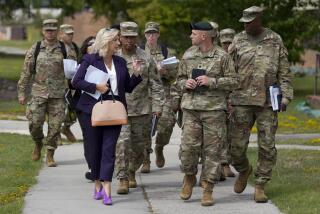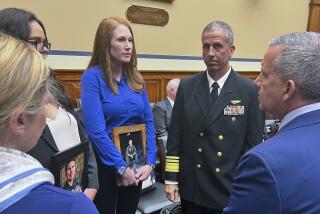Air Force aims to land more top guns amid pilot shortage
- Share via
Help wanted: At least 130 veteran military aviators for nine-year commitment to fly fighter jets.
Salary: $34,500 to $97,400. Plus good benefits and a $225,000 signing bonus — guaranteed.
Contact: U.S. Air Force by Sept. 30.
That’s the offer from the Pentagon, which is so short of Air Force fighter pilots that it’s boosting its salary package to make the job more enticing.
It may be hard to imagine that life as a high-flying fighter jock has lost its swagger, but the Air Force revealed it has a shortage of 200 fighter pilots this year. And if something isn’t done, the Air Force, which has about 3,000 fighter pilots, fears it may face a shortfall of 700 by 2021.
Empty cockpits are bad news for the military, which is already shoveling money into the development of the world’s most expensive program, the F-35 Joint Strike Fighter jet — expected to cost nearly $400 billion. The cost is a double whammy for taxpayers, because the Air Force said it costs taxpayers about $6 million to train a fighter pilot.
Several factors are behind the exodus of pilots, officials said, including a surge in demand for better-paying commercial pilots, the stresses of deployments and reassignments to fly combat drones, the remote-controlled technology that has reshaped modern warfare.
As a result, the Air Force is offering a souped-up incentive package under something called the Aviator Retention Program, which was first rolled out in 1989. The program now offers a $25,000 signing bonus per year for nine years — nearly twice as long as the usual contract.
“Were it not for the program, there would be a greater problem than the one we currently have,” said Lt. Col. Kurt Konopatzke, who oversees the program. “Senior leadership is aware of the problem and is very concerned.”
The Air Force wants to get as many of the 200 to 250 eligible fighter pilots to take the deal. Some already have signed on.
Today, just 65% of pilots are deciding to extend their service past their 11th year, when they choose whether to stay for an additional five years. That’s compared with 80% in 1993.
Air Force pilots typically earn about $90,000 by the time they complete their 11th year. The median annual wage of airline pilots, copilots and flight engineers is $103,210, according to the U.S. Bureau of Labor Statistics’ latest numbers.
There have been fighter pilot shortages in the past, but the competition promises to be fierce in the years to come as airlines hunt for young talent because of a surge in retirements.
Last year, passenger jet maker Boeing Co. released a report that estimated a global need for 460,000 new commercial pilots over the next two decades. There are currently more than 71,000 active airline pilots in the United States.
F-22 program produces few planes, soaring costs
Neither US Airways nor American Airlines, which are in the middle of merging, has hired pilots in more than a decade, and are now beginning a large-scale recruiting effort to fill spots.
US Airways and American are anticipating the retirement of more than 2,100 pilots within five years because of the mandatory retirement age of 65.
“The airlines are going to have more money to pay for pilots than the government,” said Rob Streble, 52, secretary and treasurer for the US Airline Pilots Assn., a labor union that represents US Airways pilots.
Streble knows firsthand, having left the Air Force as a pilot in the early 1990s for US Airways.
“The military is difficult on the family with all the moving around,” he said. “I added more stability by joining the airline.”
Another reason military pilots will be hotly sought after is a new Federal Aviation Administration rule that substantially raises the qualification requirements for first officers who fly for U.S. passenger and cargo airlines.
It requires commercial copilots to have 1,500 hours of flying experience, the same as captains. Currently, first officers are required to have only a commercial pilot certificate, which requires just 250 hours of flight time.
Dennis Prokopowicz, an assistant system chief pilot with JetBlue Airways, said it will be difficult for civilian pilots to achieve that many hours, but much easier for military pilots.
“Getting that kind of experience for a civilian pilot is hard to come by,” he said. “Renting a Cessna can cost around $100 per hour. You don’t have to pay for that in the Air Force.”
Prokopowicz spent 20 years flying fighter jets and attack planes in the Air Force across the globe, including Germany, Italy and South Korea, before he decided to leave.
But many decide to leave well before 20 years. The Air Force said part of the problem is finding and training new pilots. The shortage of veteran pilots has resulted in a lack of trainers.
Another logistics problem has emerged with the proliferation of drones, and the need for drone pilots. Drones went from being a handful of aircraft on Sept. 11 to the “fastest growing part of the force,” said Peter W. Singer, author of “Wired for War,” a book about robotic warfare.
The surge in drones was driven by demands for more armed systems in Iraq and Afghanistan, which led to the Air Force scrambling to find pilots for them in the mid-2000s, he said.
As a result, pilots were plucked from fighter jet assignments and placed in control of MQ-1 Predator and MQ-9 Reaper drones. In all, 153 fighter pilots were permanently reassigned to drones.
Recognizing the mounting shortage, the Air Force has stopped the practice of using fighter pilots for drones, called remotely piloted aircraft, or RPAs.
“We have in the past used fighter pilots in RPA assignments but have largely shifted away from that process and are now training pilots specific to the RPA mission,” said Konopatzke, the Air Force lieutenant colonel. “This goes back to the fact that we recognize the shortage in fighter pilots.”
John Wigle, a former F-15 fighter pilot and current program analyst in the Air Force’s operations, plans and requirements directorate, said the problem is simply an inability to put enough trained people through the military pipeline. He added that life as a fighter pilot, while often thrilling, is grueling.
“People have no idea how hard it is when you have to move your family all the time,” he said. “Military life is not for everyone.”
More to Read
Inside the business of entertainment
The Wide Shot brings you news, analysis and insights on everything from streaming wars to production — and what it all means for the future.
You may occasionally receive promotional content from the Los Angeles Times.











